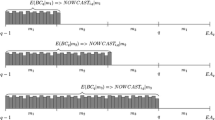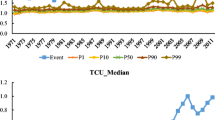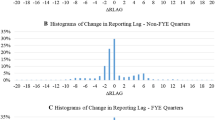Abstract
How much news is there in aggregate accounting earnings? I provide evidence that earnings changes at the stock market level are correlated with new information about not only expected future cash flows but also discount rates. A comprehensive investigation of the link to discount rates reveals that aggregate earnings changes are tied to news about all components of the expected future stock market return, i.e., the real riskless rate, expected inflation, and the expected equity risk premium. Over the sample period studied, cash flow news and discount rate news in aggregate earnings changes covary positively and have offsetting impacts on stock market prices. As a result, stock market prices appear to be insensitive to aggregate earnings changes. The findings highlight the importance of separating cash flow news from discount rate news when evaluating the information content of accounting earnings at the stock market level. Overall, my study sheds new light on the informativeness and relevance of accounting earnings for valuation at the stock market level.



Similar content being viewed by others
Notes
The cross-sectional regression model described in Eq. (8) is set up with expected accounting rate of return on equity rather than the price-to-book ratio as the dependent variable. The reason for this form of the regression is that the forecast of earnings is measured with error and should be included in the dependent variable rather than the independent variable in order to mitigate measurement error bias in the estimates of the regression coefficients.
Easton et al. (2002) report results based on a four-year forecast horizon. I use a 1-year forecast horizon for two reasons. First, the 1-year forecast horizon is less restrictive, so I can estimate the model for a more extensive panel of firms. Second, the 1-year forecast horizon circumvents the problem of additional assumptions regarding the dividend distribution policy of the average firm. As noted by Easton et al. (2002), estimates of the expected stock market return are not sensitive to varying the forecast horizon from 1 to 4 years.
Prior research identifies industry membership as a key source of cross-sectional variation in expected stock return proxies (e.g., Gebhardt et al. 2001; Easton et al. 2002; Easton and Monahan 2005). I organize firm-quarter observations into industry groups based on two-digit SIC codes. To ensure that the valuation relation described in Eq. (6) is well defined, I exclude industry-quarter observations with implied cost of capital lower than the expected growth in residual earnings. I also exclude industry-quarter observations with negative estimates of implied cost of capital because the ex ante expected nominal return on common stocks needs to be positive. The results are not sensitive to whether I define industries based on four-digit SIC codes or the Fama–French classifications.
I use lowercase letters to denote logarithmic quantities. Changes in raw quantities are indicated with Δ, while changes in logarithmic quantities are indicated with d. Unless otherwise indicated, all variables are measured in quarter t.
My analyses use the time-series of CRSP index returns, but the results are similar using the time-series of in-sample value-weighted stock returns.
The SPF is the longest and most well regarded quarterly survey of macro forecasts in the U.S. The SPF consensus projections for inflation are based on individual forecasts from a wide range of economists affiliated with major organizations and are known to outperform benchmark projections obtained from a naïve random walk and from more sophisticated autoregressive time-series models (e.g., Ang et al. 2007; Stark 2010). The distribution of individual inflation forecasts is fairly symmetric around its mean, so my results are insensitive to whether I use the median or the mean consensus forecasts from the SPF.
Although recent research has focused primarily on the link between aggregate accounting earnings and inflation (e.g., Shivakumar 2007; Cready and Gurun 2010), my findings establish a significant link between aggregate accounting earnings and all components of the expected future stock market return.
Consistent with Lettau and Ludvigson’s (2005) finding of common variation in expected stock market returns and expected growth rates, I provide evidence that cash flow news and discount rate news in aggregate earnings changes covary positively over the sample period. Relatedly, Cochrane (2011) notes that, at the bottom of a recession, both discount rates and expected growth rates are likely to be high. Menzly et al. (2004) show that a positive association between expected dividend growth and expected stock returns arises naturally in general equilibrium models with predictable dividend growth. Similar evidence is provided by Binsbergen and Koijen (2010) using a different estimation method. My evidence is also consistent with Chen’s (1991) finding that industrial production growth is negatively correlated with contemporaneous stock market returns. Campbell and Mei (1993) explain Chen’s finding by providing evidence that the generally positive impact of industrial production growth on expected future cash flows is largely offset by the negative impact of an increase in expected future excess stock market returns.
Kothari et al. (2006) find a significantly negative simple ERC at the aggregate level over the period from 1970 to 2000. The simple ERC is particularly negative during the period studied by Kothari et al. (2006) due to the impact of few quarters with large positive stock market returns and small negative aggregate earnings changes. The impact of these quarters is attenuated during the sample period examined.
Following Easton and Monahan (2005), I estimate the discount factor as the slope coefficient from the following regression: \( \left( {btm_{t - 1} + roe_{t} - ret_{t} } \right) = \rho_{0} + \rho \times \left( {btm_{t} } \right) + \varepsilon_{t} \), where btm is the log of the book-to-market ratio.
The implied cost of capital estimate assumes that the expected stock market return follows a random walk. However, my proxies for discount rate news do not require that the individual components of the expected stock market return follow random walk processes but rather embed the more general assumption that they follow AR(1) processes. This assumption is not necessarily inconsistent with the implied cost of capital estimation. This is because the sum of dependent AR(1) processes can display more persistence than the individual series. As an example, consider the case of earnings and the components of earnings. It is well documented that earnings are more persistent than the cash flow component of earnings and the accrual component of earnings (e.g., Dechow and Ge 2006).
The yield spread between the forward earnings yield of the stock market and the 10-year T-bond is also known as the “FED model”.
Thanks to Jeffrey Wurgler for making the investor sentiment data available.
Goyal and Santa-Clara (2003) find that cross-sectional dispersion in stock returns is 98 % correlated with average stock variance, so the variable RISK can be interpreted as a measure of cross-sectional dispersion or a measure of average stock variance (mostly idiosyncratic).
In additional analysis, I extend the set of instrumental variables to include the stock market dividend yield and coincident indicators of economic activity (namely, the Chicago Fed National Activity Index available from the Federal Reserve Bank of Chicago and the Anxious Index available from the Federal Reserve Bank of Philadelphia). I find that a composite index based on these additional variables does not have incremental power in explaining time-series variation in the implied cost of capital, so I present results based on the more parsimonious set of instrumental variables.
How can one reconcile the negative link between changes in expected inflation and subsequent stock market returns with a positive link between expected inflation and implied cost of capital? Given that the implied cost of capital proxies for the ex ante expected nominal stock market return, there may exist a negative association between expected inflation and the ex ante expected real stock market return. Indeed, studies dating back to Schwert (1981) provide evidence that expected inflation is negatively related to ex ante expected real returns on common stocks. Relatedly, Stulz (1986) develops a representative agent model where changes in expected inflation are negatively related to changes in the ex ante expected real stock market return. Importantly, a negative link between changes in expected inflation and changes in the ex ante expected real stock market return is consistent with evidence of a positive association between expected inflation and implied cost of capital but also could explain the negative intertemporal link to stock market returns. Alternatively, the negative link between changes in expected inflation and subsequent stock market returns could be attributable to in-sample information shocks that caused ex post realized stock market returns to measure ex ante expected stock market returns with noise (e.g., Elton 1999; Easton and Monahan 2005).
References
Ang, A., Bekaert, G., & Wei, M. (2007). Do macro variables, asset markets, or surveys forecast inflation better? Journal of Monetary Economics, 54(4), 1163–1212.
Baker, M., & Wurgler, J. (2006). Investor sentiment and the cross-section of stock returns. Journal of Finance, 61(4), 1645–1680.
Baker, M., & Wurgler, J. (2007). Investor sentiment in the stock market. Journal of Economic Perspectives, 21(2), 129–151.
Ball, R., & Brown, P. (1968). An empirical evaluation of accounting income numbers. Journal of Accounting Research, 6(2), 159–178.
Binsbergen, J. H. V., & Koijen, R. S. J. (2010). Predictive regressions: A present-value approach. Journal of Finance, 65(4), 1439–1471.
Campbell, J. Y. (1991). A variance decomposition for stock returns. Economic Journal, 101(405), 157–179.
Campbell, J. Y., & Mei, J. (1993). Where do betas come from? Asset price dynamics and the sources of systematic risk. Review of Financial Studies, 6(3), 567–592.
Chen, N. (1991). Financial investment opportunities and the macroeconomy. Journal of Finance, 46(2), 529–554.
Cochrane, J. H. (2011). Presidential address: Discount rates. Journal of Finance, 66(4), 1047–1108.
Cready, W. M., & Gurun, U. (2010). Aggregate market reaction to earnings announcements. Journal of Accounting Research, 48(2), 289–334.
Dechow, P. M., & Ge, W. (2006). The persistence of earnings and cash flows and the role of special items: Implications for the accrual anomaly. Review of Accounting Studies, 11(2–3), 253–296.
Dechow, P. M., Sloan, R. G., & Soliman, M. T. (2004). Implied equity duration: A new measure of equity risk. Review of Accounting Studies, 9(2–3), 197–228.
Easton, P. D., & Monahan, S. T. (2005). An evaluation of accounting-based measures of expected returns. The Accounting Review, 80(2), 501–538.
Easton, P. D., & Sommers, G. A. (2007). Effect of analysts’ optimism on estimates of the expected rate of return implied by earnings forecasts. Journal of Accounting Research, 45(5), 983–1015.
Easton, P. D., Taylor, G., Shroff, P., & Sougiannis, T. (2002). Using forecasts of earnings to simultaneously estimate growth and the rate of return on equity investment. Journal of Accounting Research, 40(3), 657–676.
Elton, E. J. (1999). Presidential address: Expected return, realized return, and asset pricing tests. Journal of Finance, 54(4), 1199–1220.
Fama, E. F., & French, K. R. (1989). Business conditions and expected returns on stocks and bonds. Journal of Financial Economics, 25(1), 23–49.
Gebhardt, W. R., Lee, C. M. C., & Swaminathan, B. (2001). Toward an implied cost of capital. Journal of Accounting Research, 39(1), 135–176.
Goyal, A., & Santa-Clara, P. (2003). Idiosyncratic risk matters! Journal of Finance, 58(3), 975–1007.
Hecht, P., & Vuolteenaho, T. (2006). Explaining returns with cash flow proxies. Review of Financial Studies, 19(1), 159–194.
Kothari, S. P., Lewellen, J. W., & Warner, J. B. (2006). Stock returns, aggregate earnings surprises and behavioral finance. Journal of Financial Economics, 79(3), 537–568.
Lettau, M., & Ludvigson, S. C. (2005). Expected returns and expected dividend growth. Journal of Financial Economics, 76(3), 583–626.
Menzly, L., Santos, T., & Veronesi, P. (2004). Understanding predictability. Journal of Political Economy, 112(1), 1–47.
Polk, C., Thompson, S., & Voulteenaho, T. (2006). Cross-sectional forecasts of the equity premium. Journal of Financial Economics, 81(1), 101–141.
Rao, P. (1973). Some notes on the errors-in-variables model. The American Statistician, 27(December), 217–218.
Ritter, J. R., & Warr, R. S. (2002). The decline of inflation and the bull market of 1982–1999. Journal of Financial and Quantitative Analysis, 37(1), 29–61.
Sadka, G., & Sadka, R. (2009). Predictability and the earnings-returns relation. Journal of Financial Economics, 94(1), 87–106.
Schwert, G. W. (1981). The adjustment of stock prices to information about inflation. Journal of Finance, 36(1), 15–29.
Shivakumar, L. (2007). Aggregate earnings, stock market returns and aggregate economic activity: A discussion of “Does earnings guidance affect market returns? The nature and information content of aggregate earnings guidance”. Journal of Accounting and Economics, 44(1–2), 64–73.
Stark, T. (2010). Realistic evaluation of real-time forecasts in the survey of professional forecasters. Federal Reserve Bank of Philadelphia, Special Report.
Stulz, R. M. (1986). Asset pricing and expected inflation. Journal of Finance, 41(1), 209–223.
Voulteenaho, T. (2002). What drives firm-level stock returns? Journal of Finance, 57(1), 233–264.
Acknowledgments
I wish to thank Peter Easton (editor) and two anonymous referees for their comments and suggestions. I also thank Bill Baber, Patricia Dechow, Sunil Dutta, Patricia Fairfield, Dimitrios Gikas, Prem Jain, Yaniv Konchitchki, Topseht Nonam, George Patatoukas, Stephen Penman, Andy Rose, Steve Tadelis, Jake Thomas, George Skiadopoulos, and seminar participants at the University of California at Berkeley, Athens University of Economics and Business, the University of Piraeus, Georgetown University, and the University of North Carolina/Duke 2012 Fall Camp for their comments. My thanks also to Thomas Stark from the Federal Reserve Bank of Philadelphia for his helpful discussions.
Author information
Authors and Affiliations
Corresponding author
Rights and permissions
About this article
Cite this article
Patatoukas, P.N. Detecting news in aggregate accounting earnings: implications for stock market valuation. Rev Account Stud 19, 134–160 (2014). https://doi.org/10.1007/s11142-013-9221-3
Published:
Issue Date:
DOI: https://doi.org/10.1007/s11142-013-9221-3




